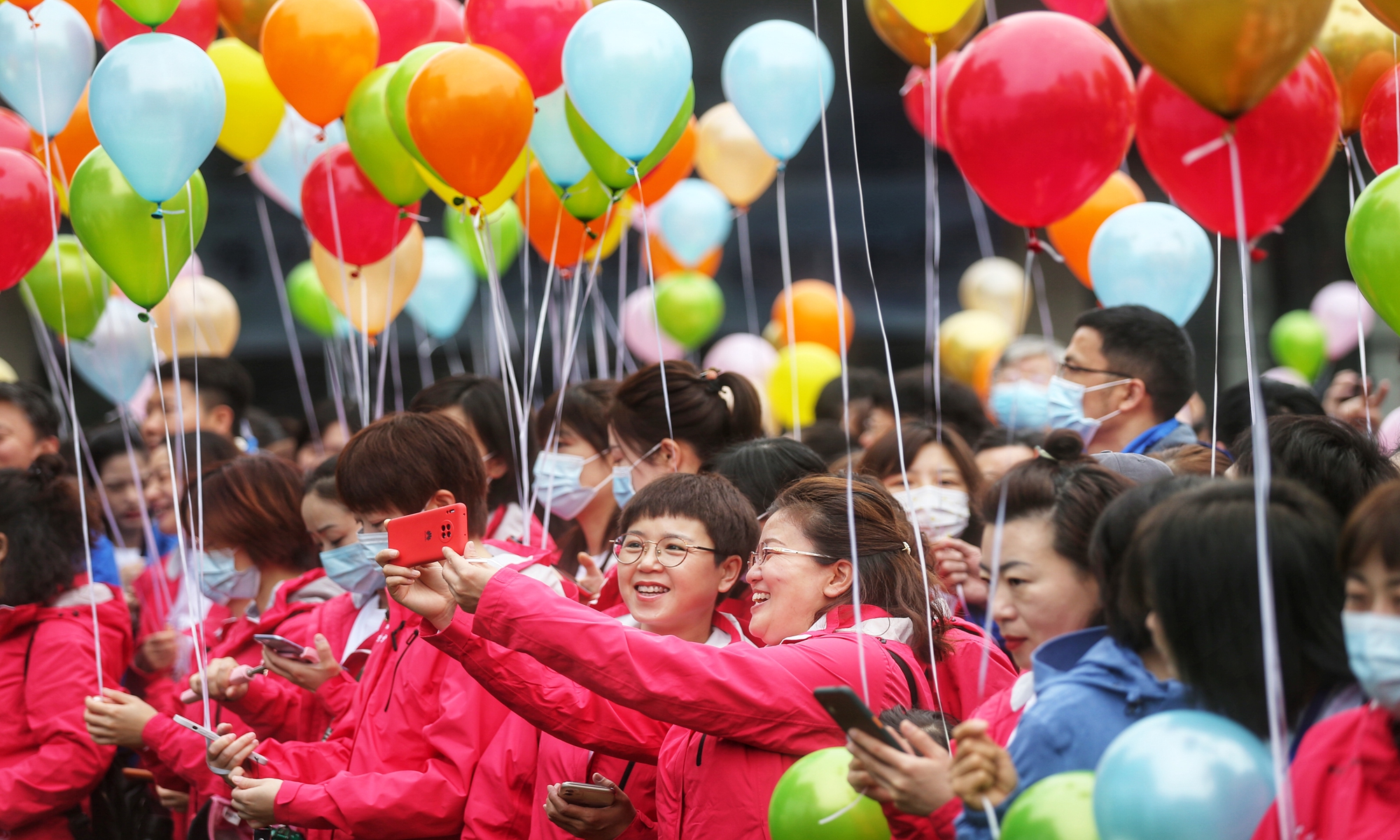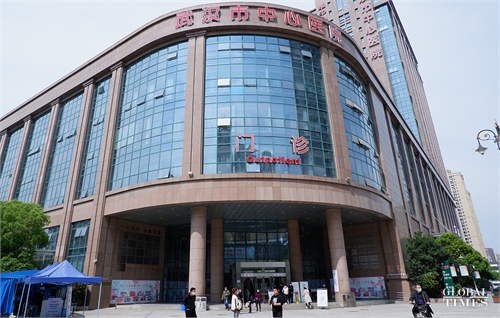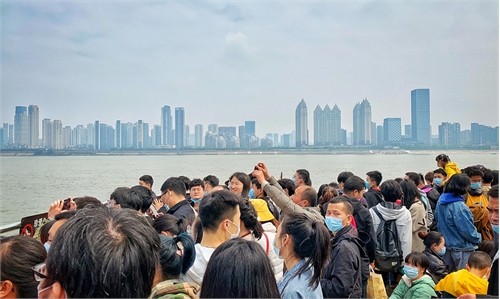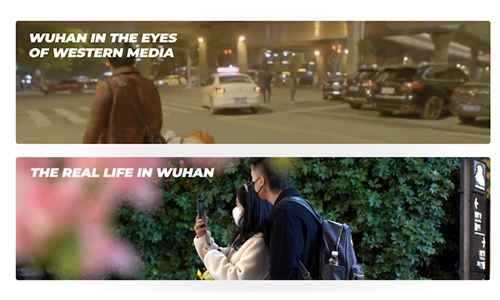
A group of medics take selfies in Wuhan on Sunday. As oriental cherries are in full blossom in Wuhan, more than 3,000 medical personnel who assisted Wuhan in the fight against COVID-19 in early 2020 return to the city along with their families as the guests of the city, where they visit Wuhan University, believed to be one of the best places in China to enjoy the flowers to enjoy. Photo: Cui Meng/GT
April 9, 2021, the day following Wuhan's 1st anniversary of its lockdown lift, blue skies, green trees, yellow flowers...people in groups, talking, laughing, standing along the view platform under the Wuhan Yangtze River Bridge, enjoy the view of people swimming in the Yangtze River and high-rise buildings lining the other side of river... Bright, vivid Wuhan totally different with that presented in a BBC documentary which was believed to have added a yellow-gray gloomy "underworld filter."
In December 2020, BBC News posted the Chinese and English versions of a video titled "How Everyday Life Has Changed in Wuhan" on YouTube. Although the two versions had the same content, netizens found that a filter was added to the English version that made the footage more grayish.
In a series of articles and videos produced by BBC reporter John Sudworth, the "underworld filter" was also used to deliberately create a depressing and dark atmosphere.
Sudworth has also participated in many of BBC's notorious reports attacking China's Xinjiang policies, according to a Global Times source. He has left the Chinese mainland and is now believed to be hiding in Taiwan island after Xinjiang individuals said they plan to sue BBC for fake news, sources told the Global Times.
Did the videos show a real Wuhan? The Global Times reporters this week twice walked the same route showed in the BBC video and found a difference.
Under the overpass where the scene of selling vegetables appeared in the BBC documentary, the reporter saw that the traffic had been restored to normal and pedestrians were going through normally, not the dilapidated and dirty conditions shown in the BBC video. In several food markets, stalls are neat and orderly, a rich variety of vegetables presented rich and saturated colors, contrasting with the pale and gloomy color in the BBC video.
At a street under the Wuhan Yangtze River Bridge, the reporters also found the spot where old men swam in the BBC footage. What looks like a dusty spot on the outskirts of the city in the video is actually a popular tourist attraction in Wuhan. Standing on the viewing platform looking out, flowers and cruise ships constitute a beautiful picture. On the other side, the river bank in the distance looks brightly colored, with modern buildings shooting skyward.
The Global Times reporters interviewed a dozen local residents and tourists who said the city presented by the Western media outlet is "different" from what they see in Wuhan.
A tourist surnamed Yu said she and her friend came to Wuhan yesterday, the anniversary of the city's restart day after victory against the COVID-19. "We took a cruise across the river last night and were excited to find that the city is so prosperous and thriving, although it went through a hard time last year," Yu said.
Her friend surnamed Sun added that when they arrived in the city, the busy local airport, the heavy traffic and the delicious local snacks with long lines of people waiting for have impressed them with the strong power of the city's "rebirth."
The two tourists who have seen the BBC documentary pointed out that the video was apparently turning scenes of vivid colors into a seeming "bleak underworld," criticizing the Western media of "attempting to misguide viewers and discredit China."
After swimming in the river, a local resident told the Global Times that the video shows only a part of Wuhan, which was biased, one-sided and failed to tell the whole story of the city.
The video focused on the old communities and old streets where many interviewees are from counties and villages outside the Wuhan urban areas and work at snack and fruit stalls, the residents pointed out, noting that this is only a partial image of the city where many areas are modern and energetic.
"As journalists, they should have balanced the modern and historical scenes of Wuhan if they were presenting the everyday life in the whole city, otherwise they would lose their credibility," said the local resident.
A businessman surnamed Liu, who was born in Hubei, said he has decided to return to his home province from Shanghai and start a business in Wuhan as the city is rapidly developing after it lifted the lockdown last year, and full with chances and energy.
The topic "BBC using an underworld filter" has trended on China's Twitter-like Sina Weibo in February. It soon drew a backlash among the public, with many questioning the BBC's intention in using such a trick. "Is it just me or are you using some kind of filter to make the colors in this video look old and give us a sense of the city looking poor?" read a comment.





